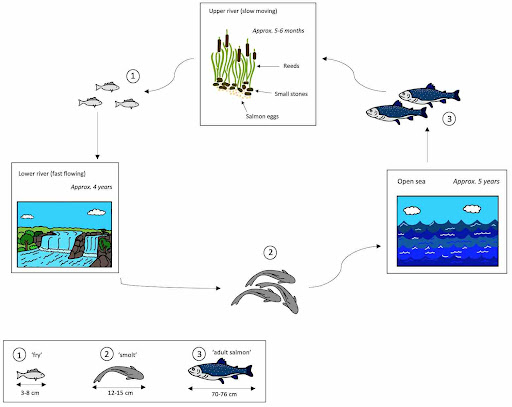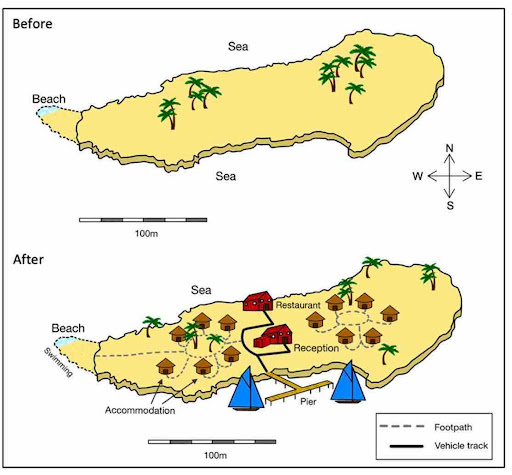How do I answer IELTS task one?
There are just five steps to answering an IELTS task one question.
- Look at and really understand what you are describing.
- Introduce with a paraphrase
- Give an overview of the key features
- Write two detailed body paragraphs
- Check your work
Let’s take a look at how to complete each of those steps.
Understand the question
This step depends on what type of question you are looking at. Your question could have a line graph, a table, a map or several other types of diagram. You don’t want to rush and simply start writing. Make sure you take a good look at what you are describing and make sure you understand it. After all, how can you describe something if you don’t know what it is like?
When you are looking at your question, make sure you look at all of the information. For example, on a line graph, make sure you look at the title, the names of each of the lines, the dates that are covered and so on.
Introduce your essay
The first sentence of your essay should tell the reader what the diagram is. In the question itself, you will see a summary. However, if you just copy this summary word-for-word, this looks bad. Instead, we can paraphrase the question. This means we should describe it in our own words. There are several methods you can use to paraphrase in IELTS task one. It is best to use more than one of these.
Change individual words in the question
For example, if the question says ‘this chart shows information’ you can change it to ‘this illustration demonstrates’.
Include more information than is in the question.
There is often extra information about the diagram that is not in the question. For example, the years covered by a line graph, the number of stages in a process diagram, or the categories in a pie chart.
Give an overview of key information
The overview is crucial to getting a high score in task one. It’s also the area which students seem to make the most mistakes. The key to this section is to pick out the most important information. However, you do not want to give any numbers or go into too much detail. In a line chart, this might mean saying that a certain line went up or down without saying what the maximum and minimum value were. Check out our full guide to task one overviews for more information.
Body Paragraphs
After you have completed your introduction and overview, it’s time to go into detail. You have two paragraphs to use here, so you need to organise your information logically between them. If you are describing a before and after map, you could spend one paragraph on before and one paragraph on after. This is the section of your essay where you can start to use numbers. That doesn’t mean you need to give every piece of data in the diagram, it should still be a summary of what is important.
Check your work
It’s always worth taking a few minutes to check your work for any mistakes. Sometimes you’ll pick up something you missed before, and if not, you can progress to the next task with confidence.
What vocabulary is useful for IELTS task one?
Task one answers can cover all sorts of topics. This means that it is hard to give a list of IELTS task one vocabulary. That said, here are some areas you can focus on:
Cohesive devices
Cohesive devices are short phrases that help organise your writing. They often go at the beginning of a sentence separated off by a comma. Some of the most useful cohesive devices are:
Overall
This tells the reader you are giving a general picture without going into specifics.
In contrast
This lets the reader know what you are about to say is different to what you just said.
First/Second/Third/Also
These are used to organise a list of information.
With regards to
This lets the reader know you’re switching to a new topic.
Describing changes
While not every task one question is about describing changes, this is very often the case. This means that it is a good idea to learn some ways to describe change.
Fluctuated/Swung up and down
Sometimes you will see the amount of something rises and falls throughout the time period of a graph.
Rose / Increased /Grew
All of these verbs can be used to say the amount of something went up.
Fell / Decreased / Dropped
These verbs are for when the amount of something went down.
Rapidly / Sharply / Steeply
These adverbs are useful for describing when a change took place quickly.
Steadily / Gradually / Slowly
These adverbs are useful for describing a slow change.
You can combine adverbs and verbs to be more precice about describing change. This will make sentences like:
- In England, the amount of coffee consumed rose gradually.
- In France, tea consumption swung up and down.
- In Italy, hot chocolate consumption fell dramatically after the year 2005.
Giving an approximate amount
Often in IELTS task one, you won’t be able to give an exact number for something. For example, on a bar chart you might not be able to see exactly how high the bar goes. In this situation, you can give an approximate amount with one of these phrases.
About / Around / Approximately
These phrases all just mean that the answer is close to the number.
Over / Just over / Slightly above
These phrases are all used to say that the amount is slightly higher than the number you are giving.
Under / Just under / Slightly below
These phrases are all used to say the amount is slightly under the number you are giving.
Giving an approximate amount is especially useful when combined with fractions. For example, you can say:
- Just over half,
- Just under a quarter
- Approximately a third.
What grammar is useful for IELTS task one?
Identifying with introductory clauses
When it comes to IELTS task one, it’s easy for your sentences to get long and confusing. One way to mitigate this is to separate some of the information out into an introductory clause. Here are some ways this might look:
- For 80 year olds, the popularity of soap operas increased from 1990 to 2000.
- With regards to people aged under 18, reality television was most popular.
- In the 18-30 age group, the popularity of cooking shows grew over this time.
Appositives
Appositives are another way of separating information off with commas. For an appositive, we’re taking extra information that isn’t essential to the meaning of a sentence and separating it with commas. For example:
- In 2015, the popularity of CDs fell to 2 million sales a year, half of what it was in 2010.
- India’s population, which is rising faster than China’s, will overtake China in terms of population in 2030 and continue to grow into 2050.
Appositives are great because they are a reliable way of injecting complex grammar into task one. This is important because some students struggle to add complex grammar here. Find out more with our complete guide to appositives.
How is IELTS task one graded?
IELTS task one is graded on the same four things as task two:
- Task response: How well you answer the question.
- Coherence and cohesion: The flow and structure of your answer.
- Grammatical range and accuracy: The use of grammar in your answer.
- Lexical resource: The vocabulary used in your answer.
However, while these have the same names as the task two grading criteria, the descriptions for different bands of task response are different. For a high band in task response, you need to do a good job giving an overview of the key features, something you don’t need to worry about in task two. You can check out the full band descriptors on the IELTS official website.
Question types in IELTS task one
Line graph
A line graph shows the amount of something over a period of time. Each line on the graph tracks a different thing. This question type requires you to describe changes represented by each of those lines.
You can check out this sample IELTS line graph essay for more information.
Bar chart
A bar chart can be used in several ways, but they all describe amounts across different categories. Bar charts can be vertical or horizontal.
Pie chart
Unlike the two types of diagram above, a pie chart shows information as a proportion. This is where the ‘just over one third’ type sentence above can come in handy.
Table
A table uses numbers rather than pictures to describe something. Students sometimes worry about tables as they think they are harder to understand. However, they shouldn’t be too complicated. Just remember to take your time to understand the key points and you’ll be fine.
Process diagram

While the first four question types in this list are all about presenting numbers, a process diagram is completely different. For a process diagram, you’ll be looking at a series of pictures that describe how something happens. The key to this is to really understand what you’re looking at and break it down into smaller stages.
Check out this example process diagram for more information. You can also check out this example of a difficult process diagram.
Maps

As you’ve probably already guessed, maps questions asks you to describe maps. This is usually a pair of maps showing a before and after picture of changes to an area.
This sample essay on maps is a great example of what you should do.
Multiple types of graph
You may see that the question has included more than one of the types of diagram above. This will just be presenting numbers to you in different ways, so just make the comparisons you need to.
IELTS task one sample essays
We have a growing list of IELTS task one sample essays that you can use to practice. Click one of the links below to take a look.
Describing a before and after map of an island.
A process diagram showing the life of a salmon.
A line graph of population in India and China.
FAQs
How many words should IELTS task one?
IELTS task one should be over 150 words. If you use fewer words, you risk losing points. There is no penalty for going over the word count. That said, spending too long on IELTS task one means you might miss out on the chance to spend time on task two.
How much time should I spend on IELTS task one?
In the exam, you have one hour to split between task one and task two. You should spend 20 minutes on task one and 40 minutes on task two.
How many paragraphs should I use in IELTS task one?
You can use three or four paragraphs in IELTS task one. For a three paragraph structure, your paragraphs would be:
- Introduction and overview
- Body paragraph one
- Body paragraph two
For a four paragraph structure, this would be
- Introduction
- Overview
- Body paragraph one
- Body paragraph two
How is IELTS task one academic different from IELTS task one general?
This guide is for IELTS task one academic. In this test, you should describe a diagram of some kind. For the general exam, this would involve writing a letter instead. We’ll have a guide to IELTS task one general in the near future, so check back soon.
What is the difference between IELTS task one and task two?
You’ll answer IELTS task one and task two in one sitting. However, the two tasks are different. IELTS task one asks you to describe a diagram while task two is about answering a question with an essay.